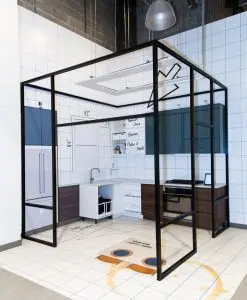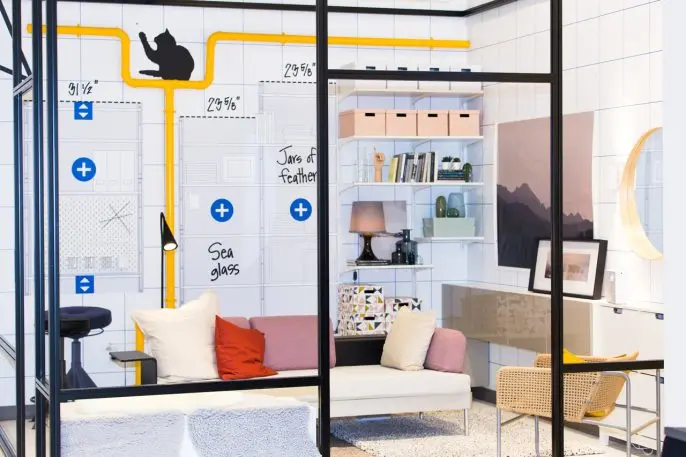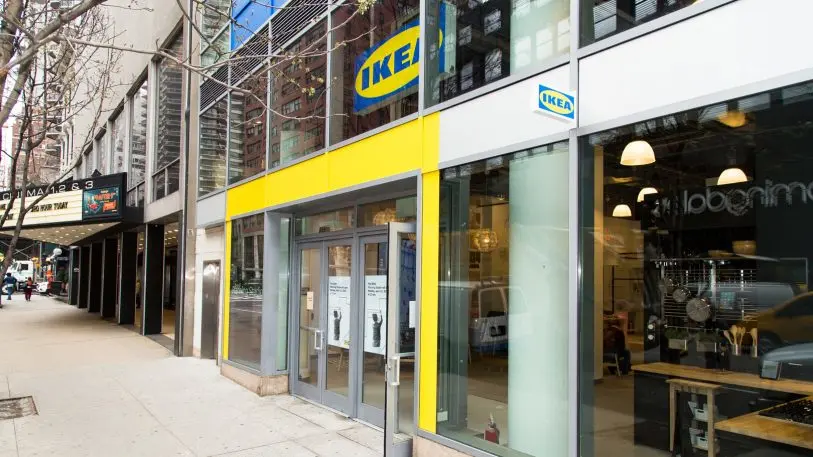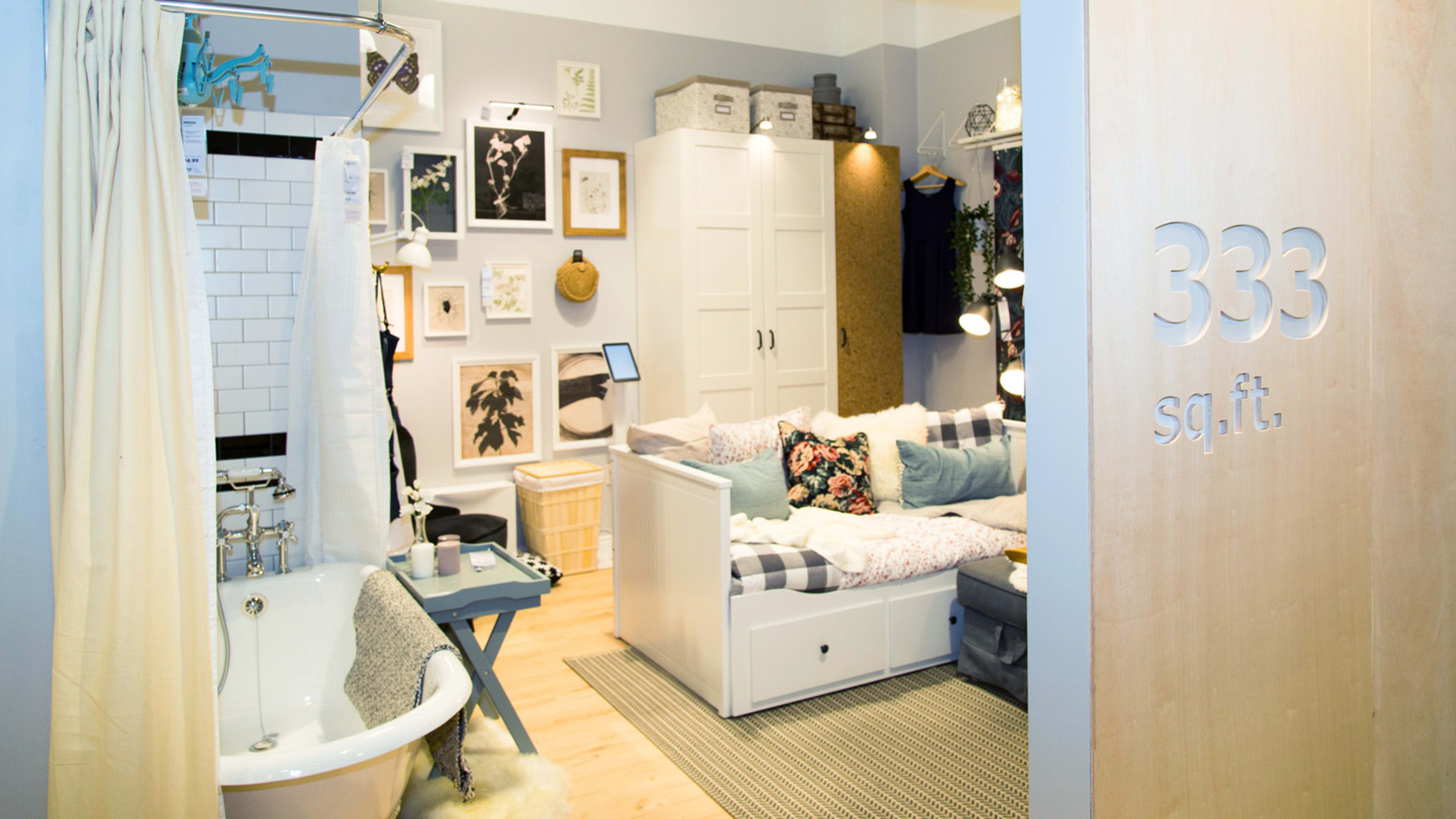Like many New Yorkers, I live in a small apartment with too little storage space. My closets are overflowing and my hand-me-down chests of drawers are falling apart. Like many people who are interested in buying furniture on a budget, my first thought is Ikea. But trekking out to Ikea’s Brooklyn superstore is a full-day commitment–one that involves lugging my new closet back with me, without a car.
Next week Ikea is opening its very first city center location in Manhattan, designed specifically to solve all of my–and most New Yorkers’–problems. Called the Ikea Planning Studio, the three-story, 17,350-square-foot store is about 5% of a normal, 300,000-square-foot Ikea, but the company has optimized it based on what New Yorkers need. Ikea employees spent months doing extensive consumer research in Manhattan and the surrounding boroughs and found, unsurprisingly, that most New Yorkers live in tiny apartments and don’t have enough space for their stuff. Neither do they have cars for schlepping furniture back to their houses–and they certainly don’t want to carry things home on the subway. (“Because sometimes your ideas are bigger than the 6 train” declares one wall near the store’s entryway.)

As a result, you can’t actually walk out of the Planning Studio with any items that you’ve bought–even small items, like vases or the myriad fake plants that dot the store. Instead, everything is shipped directly to your home, for the same delivery prices that Ikea offers for online orders (which start at $39). The Planning Studio is meant as a showroom only, combining a small percentage of Ikea products in a host of different displays inspired by New Yorkers’ actual apartments to give people examples of how they can best utilize every inch of their small spaces. Then, employees are on hand to help you create custom configurations of Ikea kitchens, closets, and storage systems, both in the showroom and on a dedicated floor–where there are six planning areas that you can book ahead of time or walk in.

Ikea’s employees in the Planning Studio are trained to help customers with whatever kind of help they need, whereas workers in the company’s traditional stores are siloed by department.
While the Ikea team learned that people hate having to find the products they want to purchase in the warehouse and wait in line to check out, their customers do love the bedroom setups that are a staple of all Ikea stores. As a result, the showroom is smartly designed around a series of studio apartments that are based on real New Yorkers’ apartments–one 333-square-foot floor plan even has a bathtub in the living room. “We basically tried to focus on the things that people love and take away the pain points,” says Amy Singer, a retail design manager who worked on the store. “And that’s what this space really is: people’s favorite things about Ikea all in one space.”
Simulations of small space living demonstrate how you can use the height of your walls in particular to increase storage, whether that’s in a living space or in a kitchen. As always, the displays are inventive and aspirational; it’s incredible how roomy a 400-square-foot studio can feel when every bit of wall is being used.

While the store isn’t displaying products that are different from what you can find at a regular Ikea, much of what it does showcase is modular, stackable, foldable, nestable, and movable–anything that provides real flexibility and convenience in a small space. New Yorkers will have one extra benefit, though: Ikea’s latest products, like its recently announced collection with African designers, will be available in the Planning Studio before they are for sale online or in its traditional stores.
This city center version of Ikea is part of the company’s bigger strategy to adapt to the way people actually shop–both online and in physical stores, while also appealing to a younger, urban audience that doesn’t have a car and is used to the convenience of ordering everything online. This shift comes out of necessity: In the 2018 fiscal year, Ikea Group’s profits dropped 26%, in part due to its investments in e-commerce, delivery, and the new city center stores. The company is cutting 7,500 jobs in a larger restructuring. It has continued to have quality control issues, with large-scale recalls particularly around its killer dressers and children’s products. It’s clear the brand has not been immune to the larger retail trends that have cratered big-box retail companies like Sears and Toys R Us.
But the city-center stores could give Ikea access to a new set of customers that may have opted for an e-commerce furniture option, like Wayfair, in the past. “It’s an accent to our existing stores… and we’re seeing significant growth, particularly in Manhattan, with e-commerce,” Sykes says. “[The Planning Studio] just allows another physical touch point for people to shop the way they’re shopping already today.”

This mixture of physical retail and e-commerce is very similar to a host of other experimental retail stores from startups. While most of these stores, like for the sustainable clothing company Everlane and makeup unicorn Glossier, allow you to take home a product, others act more like showrooms. The clothing company Bonobos and mattress startup Casper both have stores where you go to try out their products before ordering online. In that sense, Ikea is following in the footsteps of direct-to-consumer retail companies that recognize that today’s consumers still want to experience something in person, but prefer to have any purchases delivered to their door.
However, the Planning Studio wasn’t designed to be a full replacement for the iconic big-box Ikea experience. After all, the tiny showroom can’t display even a fraction of Ikea’s 9,300 products (though there are screens in every room to provide what the company calls the “endless aisle,” giving shoppers access to the full digital catalog). But it does solve a problem that the company’s suburban-centric retail strategy has so far ignored. According to Skyes, the company is looking to expand in 30 more cities, and research is already underway in Chicago; Washington, D.C.; Los Angeles; and San Francisco.
For me, this new store is exactly what I was looking for. It’s only a 20-minute subway ride from my apartment, versus the hour it would take me to get to the Brooklyn store. I’m already planning to go back and make an appointment with a specialist who can help me design a closet that can actually fit everything I need.
Recognize your brand’s excellence by applying to this year’s Brands That Matter Awards before the early-rate deadline, May 3.


















